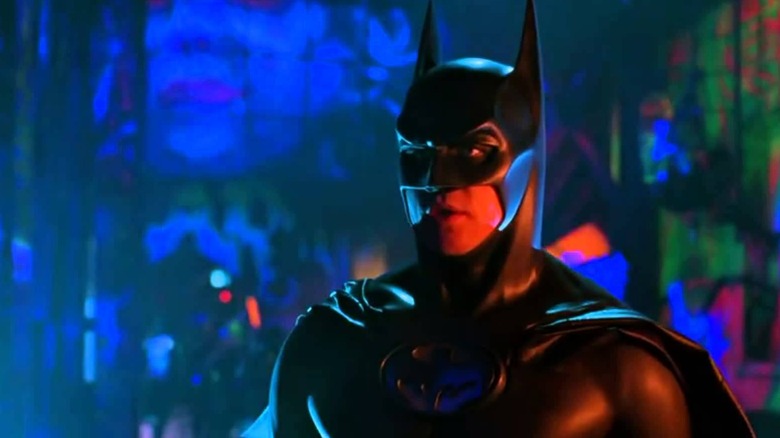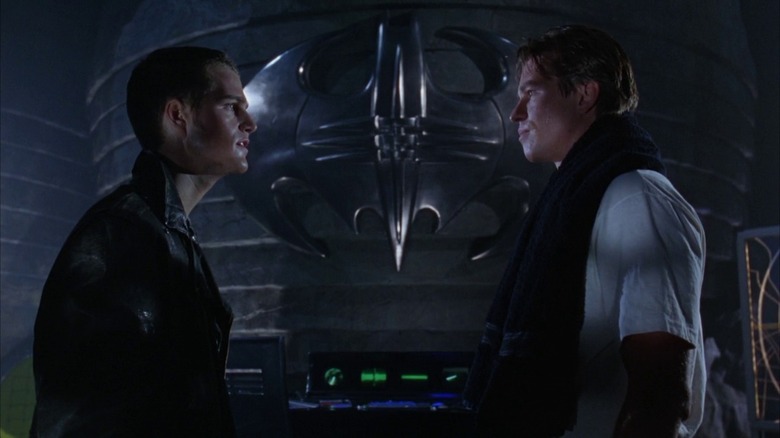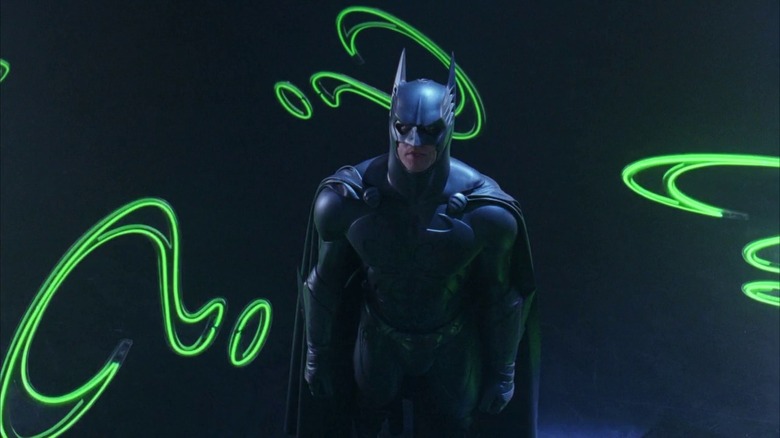Batman Forever Is Gay
(Welcome to Movies Are Gay, a Pride Month series where we explore the intentional, or accidental, ways LGBTQIA+ themes, characters, and creatives have shaped cinema.)
Joel Schumacher's Batman movies are pretty contentious among fans of the Caped Crusader, as they embraced the campier side of the character's history. Moving away from the creepy-cool goth aesthetic of Tim Burton's "Batman" and "Batman Returns," "Batman Forever" and its sequel "Batman & Robin" were colorful, campy, and unabashedly queer. Schumacher, a gay man, went on the record in an interview with Vulture in 2020 to say that he never intended for Batman or Robin to be gay in his movies, but perhaps he just made it all incredibly queer subconsciously. Both of his Batman films are deliciously camp, pulling from the 1960s' Adam West "Batman" to create a colorful comic book world, but "Batman Forever" is a bonanza of bisexuality. (If you need a refresher, you can check out both of Schumacher's bat-flicks streaming on Max.)
"Batman Forever" forces Bruce Wayne (Val Kilmer) to contend with several dichotomies within himself. He not only must come to terms with the fact that he is both Bruce Wayne and Batman, but he must learn how to let other people into his life for the first time. The latter leads him to two equally intense relationships: one with psychiatrist Chase Meridian (Nicole Kidman) and one with former acrobat Dick Grayson (Chris O'Donnell). He even ends up having to decide between them in the film's climax, eventually choosing to save both. What bi person can't relate to that?
Wrestling with an identity
Much of the runtime of "Batman Forever" is dedicated to the characters figuring out their identities. Everyone is dealing with some kind of identity crisis, whether it's Dick Grayson mourning his parents and becoming Robin or Two-Face (Tommy Lee Jones) just being Two-Face. There are a lot of binaries presented throughout the flick, both thematically and visually, and in the end most of the characters choose to break them or embrace both in some way. Batman and Robin learn to work together, Dick becomes Robin, Bruce realizes he can be Batman and Bruce Wayne, and more.
Bruce's sexuality is never explicitly discussed in "Batman Forever," even though Dr. Meridian tries to psychoanalyze him and is a big fan of Freud. The two have a fun little tryst in which she cannot decide whether she's more attracted to Batman or Bruce Wayne (another binary choice!), but it's flirtation and kisses, little more. He doesn't ever kiss Dick, but he cares about him deeply, and that care could be more than just platonic. In the above-mentioned climax, the Riddler (Jim Carrey) forces Batman to choose between Robin and Dr. Meridian. That could represent not only the character's genders, but Dr. Meridian as his "straight" life as Bruce Wayne, and Robin as his "closeted" life as Batman. He ends up saving them both, because he's Batman, and in the end he reconciles that he doesn't have to give up one life or the other, even if he's not ready to be open about both identities just yet.
Batman as bisexual allegory
Batman as a character works as an allegory for being closeted, and "Batman Forever" takes that to new levels with both its story and its aesthetic. "Batman Forever" is full to the brim with campy humor and tongue-in-cheek jokes. The camp aesthetic extends into the costumes and set design, with everyone dressed in over-the-top, incredible costumes that would look right at home at a pride parade or leather club. Seriously, the main character is wearing a rubber suit with nipples — how is that not queer? Even the hetero relationships in the movie are deliciously overdone, with Meridian playing the thirstiest therapist ever to live and Two-Face's girlfriends, Sugar (Drew Barrymore) and Spice (Debi Mazar), dressed like a pair of the fiercest drag queens.
Look, if you like your Batman straight and prudish, there are plenty of Batman movies out there for you. But "Batman Forever" is for the rest of us, and that rules.


